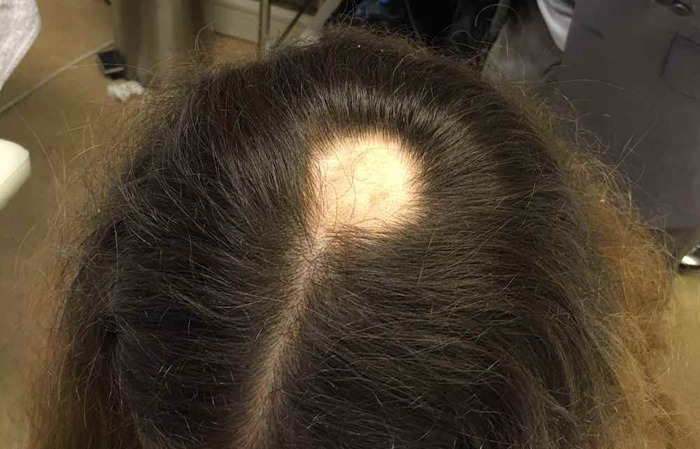
Alopecia areata is a localized loss of hair in round or oval areas without any visible inflammation of the skin in hair-bearing areas; the most common presenting site is the scalp. Alopecia totalis is loss of all scalp hair and eyebrows. Alopecia universalis, the end stage of alopecia areata, is complete loss of all body hair.
Causes of Alopecia Areata
Alopecia areata is considered an autoimmune disease. The rationale for this disorder being autoimmune is the presence of CD4 and CD8 lymphocytes around affected hair bulbs and the fact, that the T lymphocytes from the involved scalp can be transferred to explants of human scalp in mice with severe combined immunodeficiency where they induce hair loss. Also, there is an association of alopecia areata with certain HLA class II alleles, DQB1*03 and DRB1*1104, which are markers of general susceptibility to alopecia areata. Two other alleles, DRB1*0401 and DQB1*1301, are increased in patients with alopecia totalis. Although the course of alopecia areata is not altered, treatment with immunomodulating therapies such as glucocorticoids, cyclosporine, and topical immunotherapy can induce remission of alopecia areata.
Not a sign of any multisystem disease but may be associated with other autoimmune disorders such as vitiligo, familial autoimmune polyendocrinopathy syndrome (hypoparathyroidism, Addison’s disease, and mucocutaneous candidiasis), and thyroid disease (Hashimoto’s disease).
Symptoms of Alopecia Areata
AA is not a symptom of a serious disease and usually occurs in otherwise healthy individuals. Persons with AA may have a higher risk of atopic eczema, asthma, and nasal allergies, as well as other autoimmune diseases such as thyroid disease (Hashimoto’s thyroiditis), and vitiligo.
The primary symptom of alopecia areata is roundish patches of hair loss on the head, with smooth, hairless scalp in the affected areas. Alopecia totalis involves the complete loss of all scalp hair, and alopecia universalis is characterized by the complete loss of all scalp and body hair.
Diagnosis
In the diagnosis of alopecia areata, exclusion of other treatable diseases that cause hair loss such as trichotillomania and tinea capitis is important. In trichotillomania, there may be patches of broken hair and there will not be the skin changes associated with alopecia areata.
Treatment
No curative treatment is currently available. Efficacy of treatment in individual patients is difficult to assess in light of spontaneous regrowth. All in all, treatment for alopecia areata is unsatisfactory. In many cases, the most important factor in management of the patient is psychological support from the dermatologist, family, and support groups.
Glucocorticoids
Topical Superpotent agents may be effective.
Intralesional Injection Few and small Spots of alopecia areata can be treated with intralesional triamcinolone acetonide, 3.5 mg/mL, which can be very effective temporarily.
Systemic Glucocorticoids Usually induce regrowth, but alopecia recurs on discontinuation; risks of long-term therapy therefore preclude their use.
Systemic Cyclosporine Induces regrowth, but alopecia recurs when drug is discontinued.
Induction of Allergic Contact Dermatitis Dinitrochlorobenzene, squaric acid dibutylester, or diphencyprone can be used successfully, but local discomfort due to allergic contact dermatitis and swelling of regional lymph nodes poses a problem.
Oral PUVA (Photochemotherapy) Variably effective, as high as 30%, and worth a trial in patients who are highly distressed about the problem. The entire body must be exposed, in that the therapy is believed to be a form of systemic immune suppression.
References